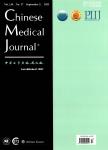Clinical and Angiographic Predictors of Major Side Branch Occlusion after Main Vessel Stenting in Coronary Bifurcation Lesions
Clinical and Angiographic Predictors of Major Side Branch Occlusion after Main Vessel Stenting in Coronary Bifurcation Lesions作者机构:Department of Cardiology State Key Laboratory of Cardiovascular Disease Cardiovascular Institute Fuwai Hospital and National Center for Cardiovascular Diseases Chinese Academy of Medical Sciences and Peking Union Medical College Beijing 100037 China
出 版 物:《Chinese Medical Journal》 (中华医学杂志(英文版))
年 卷 期:2015年第128卷第11期
页 面:1471-1478页
核心收录:
学科分类:0831[工学-生物医学工程(可授工学、理学、医学学位)] 1004[医学-公共卫生与预防医学(可授医学、理学学位)] 08[工学] 080101[工学-一般力学与力学基础] 0801[工学-力学(可授工学、理学学位)] 10[医学]
基 金:TheBeijingMunicipalScienceandTechnologyCommission(No.Z141107002514096) PUMCYouthFundandFundamentalResearchFundsfortheCentralUniversities(No.33320140166)
主 题:Coronary Bifurcation Lesions Major Side Branch Occlusion Percutaneous Coronary Intervention
摘 要:Background: Major side branch (SB) occlusion is one of the most serious complications during percutaneous coronary intervention (PCI) for bifurcation lesions. We aimed to characterize the incidence and predictors of major SB occlusion during coronary bifurcation intervention. Methods: We selected consecutive patients undergoing PCI (using one stent or provisional two stent strategy) for bifurcation lesions with major SB. All clinical characteristics, coronary angiography findings, PCI procedural factors and quantitative coronary angiographic analysis data were collected. Multivariate logistic regression analysis was performed to identify independent predictors of SB occlusion. SB occlusion after main vessel (MV) stenting was defined as no blood flow or any thrombolysis in myocardial infarction (TIMI) flow grade decrease in SB after MV stenting. Results: Among all 652 bifurcation lesions, 32 (4.91%) SBs occluded. No blood flow occurred in 18 lesions and TIMI flow grade decreasing occurred in 14 lesions. In multivariate analysis, diameter ratio between MV/SB (odds ratio [OR]: 7.71,95% confidence interval [C/]: 1.53-38.85, P = 0.01), bifurcation angle (OR: 1.03, 95% CI: 1.02-1.05, P 〈 0.01), diameter stenosis of SB before MV stenting (OR: 1.05, 95% CI: 1.03-1.07, P〈 0.01), TIMI flow grade of SB before MV stenting (OR: 3.59, 95% CI: 1.48-8.72, P〈 0.01) and left ventricular eject fraction (LVEF) (OR: 1.06, 95% Cl: 1.02-1.11, P 〈 0.01) were independent predictors of SB occlusion. Conclusions: Among clinical and angiographic findings, diameter ratio between MV/SB, bifurcation angle, diameter stenosis of SB before MV stenting, TIMI flow grade of SB before MV stenting and LVEF were predictive of major SB occlusion after MV stenting.



